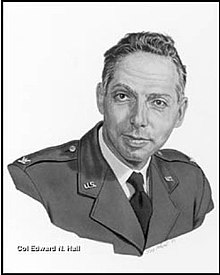Edward N. Hall
Edward N. Hall | |
|---|---|
 1989 drawing of Hall | |
| Born | 4 August 1914 New York City, US |
| Died | 15 January 2006 (aged 91) Torrance, California, US |
| Service/ | |
| Years of service | 1939–1959 |
| Rank | Colonel |
| Battles/wars | |
| Awards | Legion of Merit (4) |
| Relations | Theodore Hall (brother) |
Edward Nathanial Hall (August 4, 1914 – January 15, 2006) was a leading missile development engineer working for the US and its allies in World War II and the late 20th century.
Early life[]
Hall was born in Forest Hills, Queens, New York City, the son of Rose Moskowitz and Barnett Holtzberg, a furrier. His family was Jewish. He attended Townsend Harris High School. He received a Bachelor in engineering from College of the City of New York in 1935 and a professional degree in chemical engineering in 1936. In 1948, he earned a Master of Science in aeronautical engineering from the California Institute of Technology.[1] He was the brother of Theodore Hall, an accomplished physicist who became an atomic spy.[2]
World War II[]
Hall entered the Air Corps 1939. During World War II he served in England in engineering assignments associated with aircraft repair. His introduction to missiles came near the war's end when he was assigned to acquire intelligence on Germany's wartime propulsion work. In 1943, he received his first of 4 Legion of Merit for airplane spar repairing that saved several days by eliminating the stripping the skin from the wings to replace the spar. Plates that spanned the fractured spar were connected with oversized pins, forced through holes drilled through the plate/spar overlap using extreme hydraulic pressure.
Missile development work[]
Hall became Assistant Chief, Non-Rotating Engine Branch, Power Plant Laboratory, Wright-Patterson Air Force Base, where he participated in the development of solid and liquid rocket power plants. In 1951, he was one of four people at Wright Air Development Center (WADC) who were instrumental in the initiation of Project MX-1593, the Atlas program.[3]
In 1954, Hall joined Western Development Division as Chief, Propulsion Development, where he was responsible for the programs leading to development of engines for the Atlas, Titan, and Thor missiles. In 1957, he became director of the Weapon System 315A (Thor) development program and, subsequently, oversaw installation of Thor missiles in England. Hall directed the Weapon System 133A (Minuteman) program until the eve of the missile's first complete flight test.[4]
Edward Hall was selected to take the lead in designing, developing, producing, and deploying a nuclear-tipped intercontinental ballistic missile for NATO. Retiring from the Air Force in 1959, Hall joined United Aircraft Corporation.
In 1999, he was elected to the .[5]
Family[]
Hall was married to Edith Shawcross. They had three children — a daughter, Sheila, and two sons, David and Jonathan.
Hall's brother, Theodore Hall, worked for the Manhattan Project and passed nuclear secrets to the Soviets.
Edward N. Hall died on January 15, 2006.
Further reading[]
- Dave Lindorff, "Brothers against the Bureau: Ted Hall, the Soviet Union's youngest atomic spy, his rocket scientist brother Ed, and the untold story of how J. Edgar Hoover's biggest Manhattan Project bust was shut down", The Nation, vol. 314, no. 1 (10–17 January 2022), pp. 26–31.
External links[]
- ^ Rocketaholic: Edward N Hall http://rocketaholic.blogspot.com/2006/01/edward-n-hall-91-rocket-pioneer-seen.html
- ^ A Fiery Peace in a Cold War: Bernard Schriever and the Ultimate Weapon/Neil Sheehan
- ^ Air Force Space Command "Archived copy" (PDF). Archived from the original (PDF) on 2012-06-14. Retrieved 2012-02-28.
{{cite web}}: CS1 maint: archived copy as title (link) - ^ Global Security: ICBM http://www.globalsecurity.org/wmd/systems/lgm-30_1.htm
- ^ NY Times obituary https://query.nytimes.com/gst/fullpage.html?res=9B03E6DE153FF93BA25752C0A9609C8B63
- American aerospace engineers
- New York University alumni
- California Institute of Technology alumni
- 1914 births
- 2006 deaths
- Recipients of the Legion of Merit
- United States Air Force officers
- 20th-century American engineers